Written by Polina
Bakhteiarov
New Orleans’
unique culture and
traditions constitute one of the most important reasons for why the
city should
be rebuilt and preserved. The multi-layered history of New Orleans was
derived
from the city’s initial function as the major slave trade port of the
United
States, which brought in countless Africans, many of whom remained in
the city
as both slaves, and eventually, free men and women. Today’s traditions
of
NOLA’s neighborhoods grew out of the customs of this wide variety of
people in
the late 1800’s. The city established its own style of food,
storytelling, and
religious ceremonies because its population was so diverse and unique,
unmatched by that of any other American city. Below, we consider just
some of
the cultural aspects that are vital to the spirit of New Orleans.
Parades
and festivals
New Orleans is
known
domestically and internationally as the “city of festivals,” with the
most
famous parade of all being Mardi Gras, or “Fat Tuesday.”
 picture
from:
http://www.asergeev.com/pictures/archives/2006/504/jpeg/13.jpg
picture
from:
http://www.asergeev.com/pictures/archives/2006/504/jpeg/13.jpg
No
one can exactly
pinpoint the birthdate of this gigantic carnival because it formulated
as a
hybrid of multiple festivities that had been taking place throughout
the city
since its Westernization began in the 18th century. The
French had
been hosting masked balls and carnivals in New Orleans since as early
as 1718,
and they continued to do so until these festivities were banned by the
Spanish,
but later reinstated by the Americans in 1827 (Mardi Gras History,
2006).
Mardi
Gras is essentially comprised of a collection of “krewes,” or
bands of people, who construct their own floats and/or organize
themselves to
parade during the festival (this also applies to the other carnivals of
NOLA).
The first krewe, formed in 1857, was called the Mystick Krewe of Comus,
and, in
essence, single-handedly initiated the tradition of Mardi Gras, since
the
second krewe – the Krewe of Rex – was not established until 1872.
Today, the
massive parade entails everything from beads to masks to culinary
specialties
like King Cake (Mardi Gras History, 2006).
And
yet, there are numerous other festivals that might be less well
known to outsiders but are just as important to the people of New Orleans.
They include events such as the
Jazz Fest and Heritage Festival, pictured below.
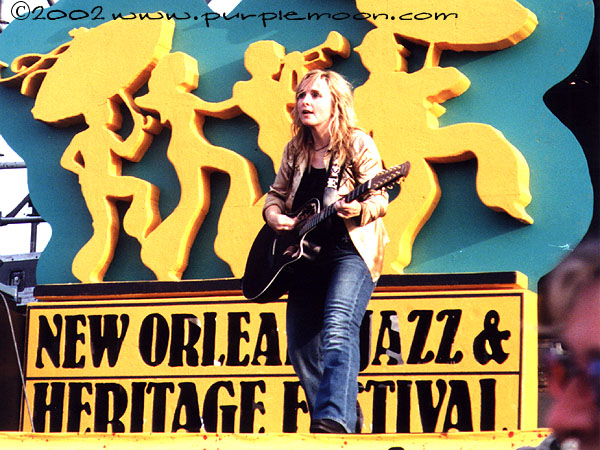 Picture from: www.purplemoon.com
Picture from: www.purplemoon.com
This festival showcases
a
mixture of local and national music talents and is essential to the
preservation of New Orleans’
indigenous musical culture. Featuring famous acts like Bob Dylan, Paul
Simon,
Dave Matthews, Fats Domino, the Meters, Dr. John, Yolanda Adams, Elvis
Costello, the Rebirth Brass Band and the Preservation Hall Jazz Band,
Jazz Fest
is also a folk festival that is the perfect platform upon which local
talent
can showcase their compositions. In addition, there are numerous other
parades
and carnivals that occur during carnival season, such as Festival
National
(celebrating Francophile culture), Ponchatoula Strawberry Festival,
French
Quarter Festival, and the New Orleans Wine and Food Experience, just to
name a
few (New Orleans Spring Festivals 2006, 2006).
Food
New Orleans is the only
metropolis in the world that can claim to have conceived its own style
of food.
Both Creole and Cajun meals originated in the city, and are actually,
to many
people’s surprise, not interchangeable. The
Creole style of cooking, founded in the heart of New
Orleans at the turn of the 18th
century, was first
adopted by freed and enslaved Blacks, and, over time, became the
preferred
style of food preparation for people of a multiracial background,
including
African, Caribbean, European, and
Native
American. Creole cuisine has been passed down through generations as a
concoction of “iron-pot delicacies” that require ingredients that are
inexpensive and easily accessible, such as rice, greens, and chicken
giblets,
but that result in a delicious meal.
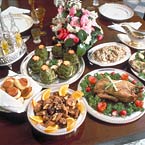
http://www.frenchquarter.com/s_images/city_food.jpg
Cajun gastronomy, on
the other hand, developed from the decedents of
Acadian (later called “Cajun”) exiles, who began arriving in New Orleans
around the 1760’s. Forced into
permanent isolation from their native land, the Acadians tried to
retain their
culture as much as they could and food was one of the means by which
they could
accomplish this. While Creole cooking mixed many different styles,
Cajun
cuisine was tailored to include ingredients that could easily be grown
in the
Nova Scotian climate (that of the Cajuns’ native land) and since most
of these
deportees were farmers, their cooking center around root vegetables,
corn, and
meat from livestock. Over time, these two cooking cultures blended
together to
form what today is known as “South Louisiana cuisine,” which is most
famous for
crawfish and gumbo dishes (Food, 2006).
Music
Not
only did New Orleans
birth a new
style of food, but it is also the founding place of the only indigenous
American music – jazz. Renowned musicians such as cornet player, Buddy
Bolden,
soprano saxophonist Sidney Bechet, and the world famous trumpeter Louis
Armstrong all called New
Orleans
home. Jazz is truly a byproduct of the cultural history of New Orleans, since it came about from the influx
of European, African,
and Caribbean music that settlers and
slaves
brought with them to NOLA during the 18th century; these
different
styles became permanently mixed as more Blacks were freed and the
population of
multiracial people grew throughout the city. Fueled by the relaxed,
liberal
attitude of the city, this fusion of music came to be known as jazz.
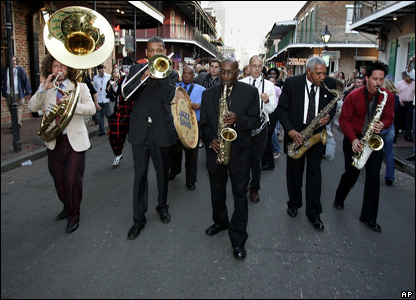
http://newsimg.bbc.co.uk/media/images/41616000/jpg/_41616520_jazzplayers_ap.jpg
The music style of
jazz originated from many different traditions that
the Blacks, Germans, Irish, and Italians settling in uptown New Orleans
introduced into the city. The
“Creoles of color,” who were extremely skilled musicians of both
African and
European heritage, brought their professionalism. African slaves
introduced New
Orleans to African drumming and dancing, a tradition that, even as
slaves, they
upheld every Sunday, gathering in what came to be known as Congo
Square, which
is located across Rampart Street, just behind the French Quarter.
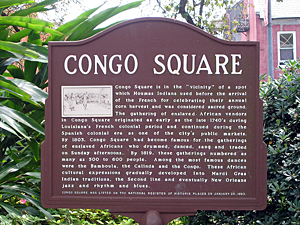
http://freelargephotos.com/000316_s.jpg
After the dancing in
Congo Square was shut down during the Civil War,
Blacks began to organize in “gangs of Mardi Gras Indians;” they would
paint
their faces in the style of the Native Americans and parade through the
streets, challenging rival gangs to battles of strength. Sure enough,
these
shows consisted of call-and-response chanting, as well as drumming,
both of
which evolved from West African and Caribbean
cultures. Finally, at the close of the 19th century,
syncopated
music, such as the cakewalk and the minstrel tune, the roots for which
originated in Black communities, became the craze of the nation, and
the seeds
of jazz were planted (Jazz History, 2006).
Burial
Traditions
A unique aspect of New
Orleans culture surrounds the city’s
method of burying the dead. NOLA is quite famous for the “jazz
funeral,” which
is a lavish extravagance that, unfortunately and ironically, the poor
of the
city never get to experience until it is being held for themselves.
Furthermore,
Blacks in New Orleans
were never allowed to hold jazz funerals until the 1970’s, which was
just one
way in which this significant subpopulation’s culture was stifled.
However, in
the past 35 years, jazz funerals have gained great popularity and have
evolved
to include a larger parade of people and more modern music.
The funeral is
broken up into two parts: the “somber journey” to the
cemetery and the jubilant return from it. According to tradition, the
brass
band arrives at the place where family and friends are paying their
respects to
the deceased (usually in a funeral parlor or church) and the musical
ensemble
leads a solemn procession of mourners through the streets, playing
traditionally Black Protestant hymns, such as “Just a Closer Walk With
Thee.”
At the head of the march is the grand marshal, who is either part of
the band
or of the social club of the departed; this figure sets the grave mood
of the
procession by dressing all in black, holding his black hat in his
hands, and,
with his head up high, marching slowly to the graveyard. If the family
can
afford it, the open casket is pulled by a horse-drawn carriage.
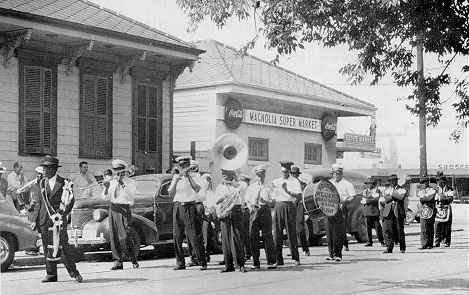
http://images.scripting.com/archiveScriptingCom/2005/08/31/fullJazzFuneral.jpg
After the deceased
has been laid to rest, the band
guides the march
away from the grave, and once everyone is a respectable distance from
the site,
the lead trumpeter gives a two-note signal to the percussionists begin
to play
the “second line” beat, an indication that the celebration is about to
start.
The grievers open gorgeously-decorated umbrellas and fall in line with
the band
as everyone begins to perform the strut-like dance called the “booty
bounce” to
the music of songs such as “Didn’t He Ramble,” As the now festive
parade returns
from the graveyard, the joyous music alerts the neighbors of the
impending
celebration and the dancing grand marshal among the second-liners
serves as
assurance “that another soul has gone on home” (Marsalis, 1998).







 picture
from:
http://www.asergeev.com/pictures/archives/2006/504/jpeg/13.jpg
picture
from:
http://www.asergeev.com/pictures/archives/2006/504/jpeg/13.jpg Picture from: www.purplemoon.com
Picture from: www.purplemoon.com










